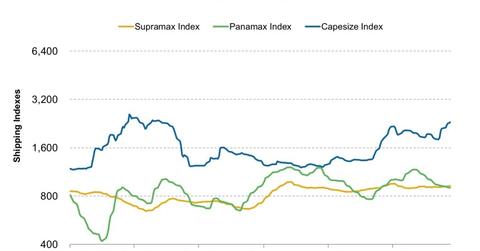Why shipping rates for Capesize vessels continue to outperform
Investors can look forward to higher Capesize rates during the second half of this year compared to the first half, which is positive for dry bulk shippers.
Nov. 20 2020, Updated 5:01 p.m. ET

Supply and demand drives dry bulk shipping companies
Unlike imports data that aren’t widely available on a weekly basis, shipping rates (which reflect the difference in supply and demand) are collected daily at the London-based Baltic Exchange and published as the BDI (Baltic Dry Indexes). These indexes reflect the daily shipping rates to transport key dry bulk raw materials in the spot market. When demand outpaces supply growth, shipping rates tend to rise. But when an increase in supply doesn’t meet with demand, shipping rates fall. [1. The two main revenue generation models in the shipping industry are spot (voyage) and time (period) charters. “Spot charters” refer to the one-time price of shipping a specific amount of raw material, while “time charters” reflect the price of borrowing a ship’s service for a specific period. “Time Charter Equivalent” (TCE), which converts spot charters (specified in $ per ton) to time charter rates ($ per day), is often used to compare companies in different markets. The two often mirror each other over the medium and long terms.]
Capesize continues to outperform
From August 16 to 23, the Panamax BDI index continued its fall, from 923 to 903. Capesize and Supramax indexes, on the other, rose from 2,112 to 2,312 and from 916 to 927, respectively. The increase in shipping rates for Capesize likely reflects higher iron ore shipments, which are used to carry primarily iron ores and coals. While Panamax also carries them, Panamax vessels are smaller and are also used for other dry bulks, like grain. The decline in shipping rates shows that new ship deliveries for Panamax vessels remain elevated.
Past patterns, support, and upsides
Historically, rates for Capesize vessels have risen during the second half of the year, as shipments out of Australia and Brazil grew. This year, we may experience the same pattern as new mining capacity comes online. Higher shipments would mean less incentive for companies to scrap or delay vessels—unlike last year, when the Capesize index fell to just above 1,200. That could limit upside potential in Capesize rates, but it also means that if rates were to fall back to just 1,200, companies would likely delay extra new deliveries and scrap old vessels again, which would support shipping rates.
Outlook for shipping rates and implication
Investors can look forward to higher Capesize rates during the second half of this year compared to the first half, which is positive for dry bulk shippers like DryShips Inc. (DRYS), Navios Maritime Partners LP (NMM), Diana Shipping Inc. (DSX), Safe Bulkers Inc. (SB), and Navios Maritime Holdings Inc. (NM) that all carry Capesize vessels. If rates do fall, it would present a long-term opportunity, since rates are turning around, and it would suggest that investors shouldn’t get spooked. As there are some overlaps in the kinds of dry bulks each vessel carries, higher Capesize rates will also support Panamax vessels, and to a minor extent, Supramax vessels too.
For other interesting indicators, please visit our Marine Shipping page. We also recommend two additional indicators published last week, starting with forward contracts, where you’ll see the second indicator as well.
Disclosure: I own shares in Diana Shipping Inc.
